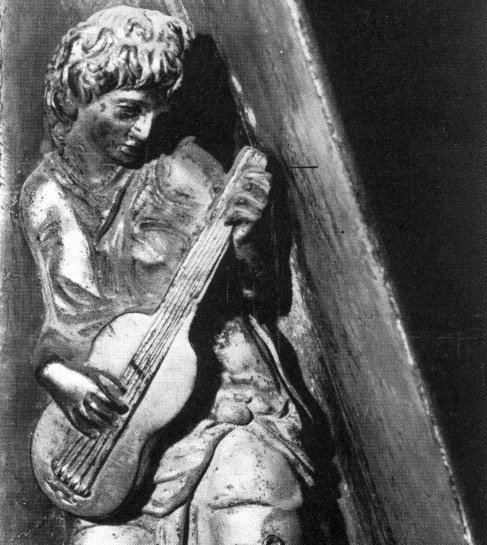Vihuelist, sculpture by Juan Nicolás de Vergara.
(1560-1580?) - Toledo Cathedral, Choir, Lectern
instrument: vihuela de mano | century: 16cent/2/mid | catalogue nº: 16-230

Artwork
Creator Vergara el Mozo, Juan Nicolás de
Medium Artwork: Sculpture
Location
City Toledo | Region Castilla-La Mancha | Old kingdom Castile
Characteristics
| Body Waisted | Strings 5 strings | Neck Long | Pegbox None |
| Bridge Fixed | Frets No | Back Vaulted | Pegs None |
| Technique Plucked fingers thumb out |
Commentary
ARTWORK
One of two lecterns (facistol) in the choir of Toledo Cathedral with cast bronze figures of vihuelists. The other (16-231) depicts a player of a bowed vihuela de arco. These are the work of Nicolás de Vergara, el mozo (1540-1606).
INSTRUMENT
This vihuela is clearly depicted with five single strings, its pegbox is missing from the sculpture or was never included. The instrument is plucked with the fingers, with the thumb out. Romanillos confirms that this vihuela has a vaulted back made of multiple ribs. He also suggests that there are two vihuela de mano sculptures here, not just the pair of vihuela de mano and vihuela de arco. This requires to be clarified. The body of the vihuela is well proportioned, the bridge is close to the lower end and the sound hile is presumably under the player’s hand or not included. The neck is quite long, with a neck-body join at about the twelfth fret.
Romanillos commentary is worth quoting here in full: “In the two lecterns by Juan Nicholas de Vargara [sic] in the choir of Toledo Cathedral one can see in the cast figures of both vihuela de mano players that both instruments have vaulted backs as well as cercos - ribs. It could be argued that in those particular lecterns the vaulted backs of the two vihuelas could be the result of the casting methods and that the vaulted back was left bulging, rather than flat in the part of the instruments that was hidden. However, the meticulous work seen throughout the two panels in the lecterns in which several other musical instruments are depicted rules out the possibility that the backs of the two vihuelas de mano were not represented in their true shape.” (romanillos1987, 41)